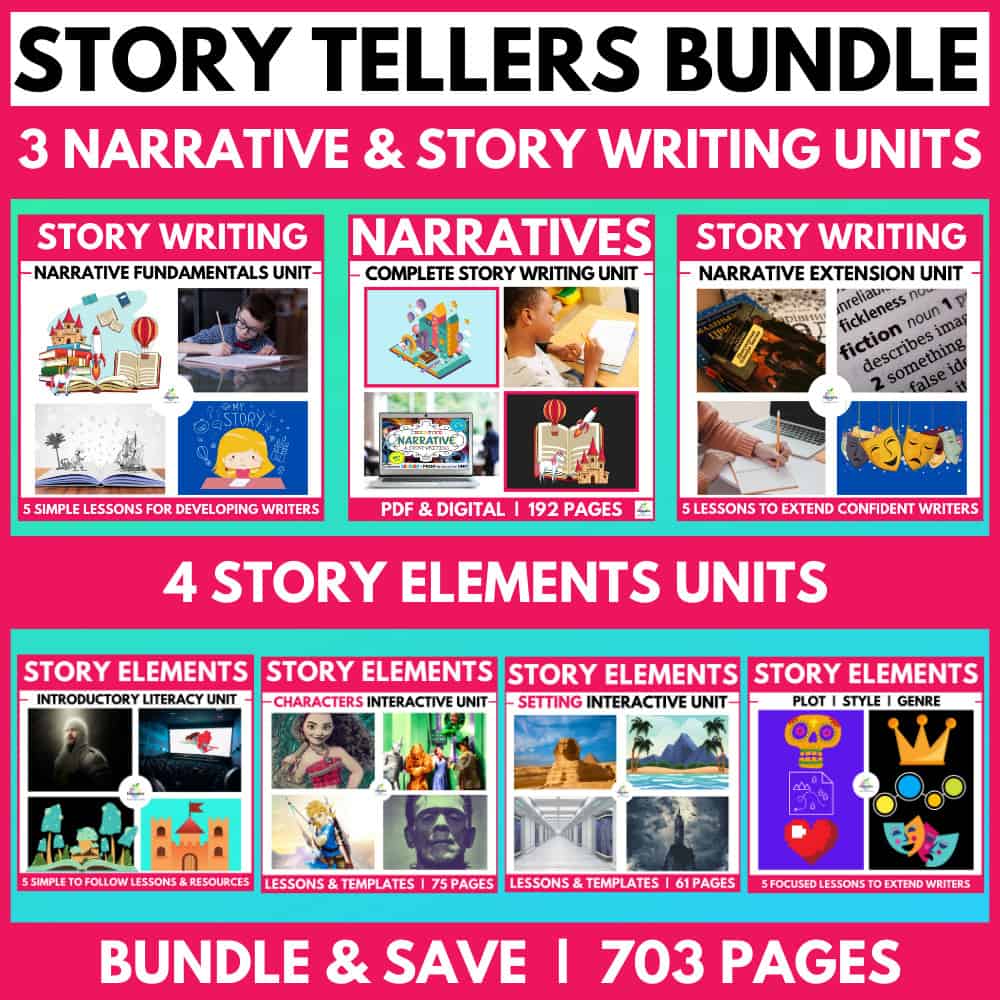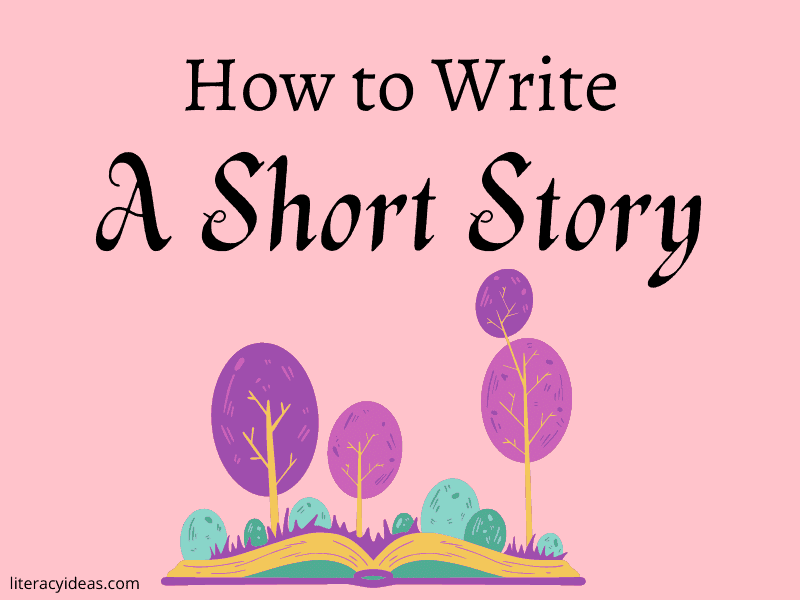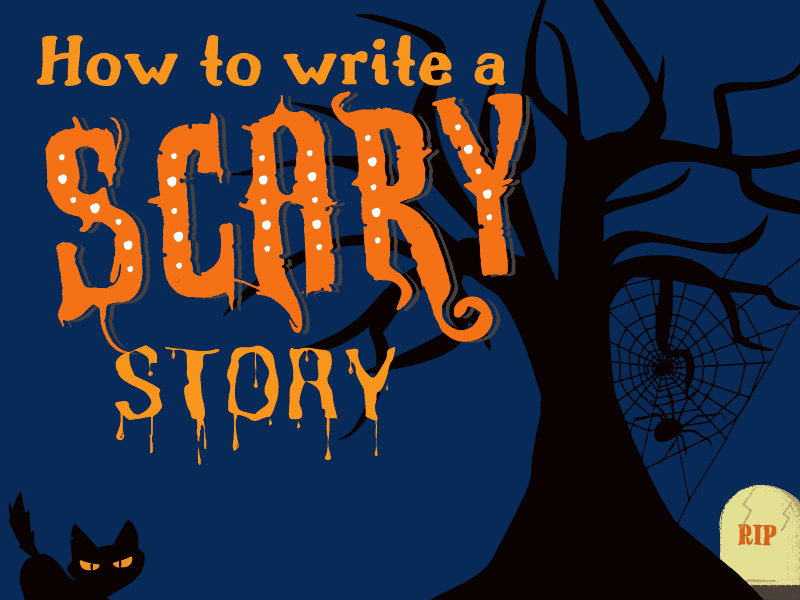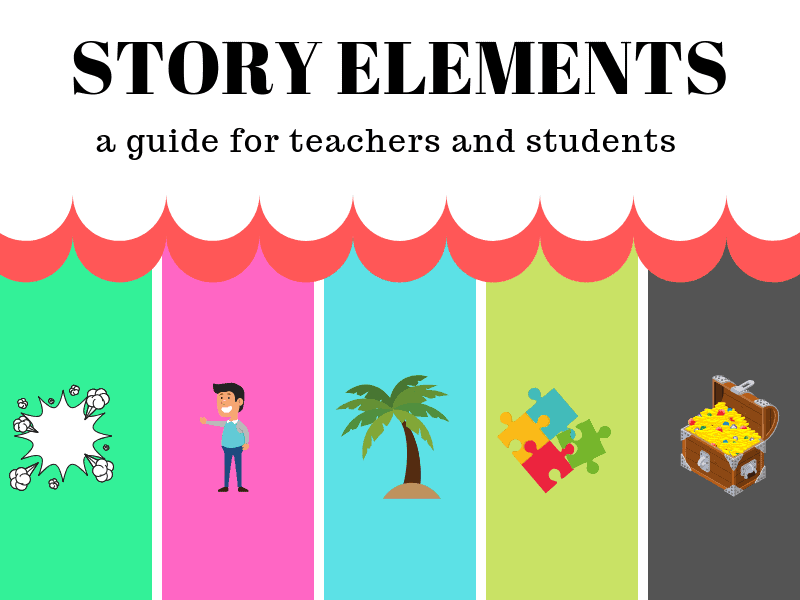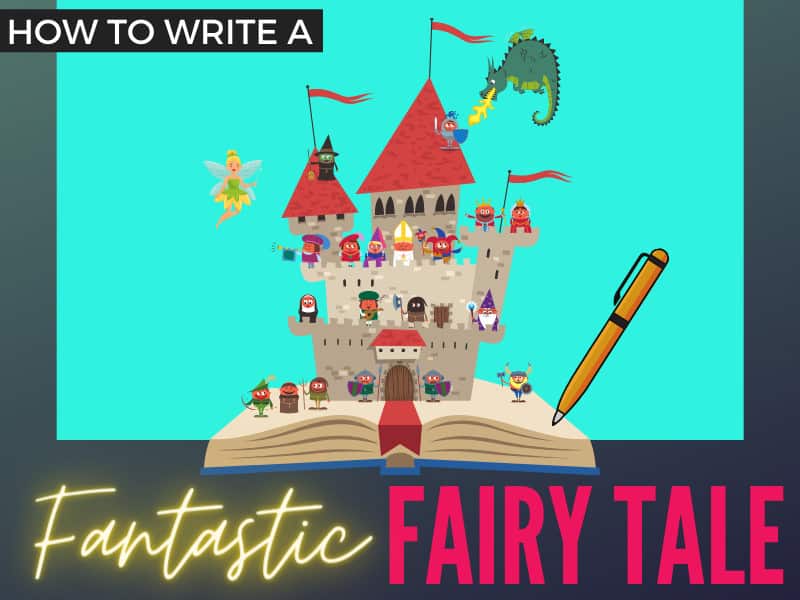
Once upon a time, we sat on the floor, mesmerized as a favourite adult read stories brimming with evil stepmothers and beautiful princesses from our favourite big picture book. There may even have been a talking animal or two.
Frequently, fairy tales are our very first encounters with structured stories.
In childhood, these stories appear as nothing more than simple diversions, usually booked-ended with the stylized opening Once upon a time and ending with a conventional… And they all lived happily ever after.
At first glance, we could be forgiven for thinking these simple tales belong only as bedtime stories in our earliest childhood.
However, fairy tales offer our students and us so much more than this. And that’s what we’ll explore in this article.
What is a Fairy Tale?

We all know one when we see one. But if we are to teach our students to write their own fairy tales, we’ll first need to nail down a solid fairy tale definition.
Fairy tales are a distinct genre within the broader genre of folktales. Like all types of folktales, the origins of many of these stories predate our ability to write things down.
Due to their origins in oral traditions, many versions of the most famous fairy tales exist. The same broad story differs from place to place and culture to culture due to an international game of Broken Telephone played across space and time.
When the Grimm Brothers published hundreds of fairy tales in the 19th century, many of these once-shifting tales became crystallized in the imagination. Work that the likes of Disney continue to this day.
Some of the best-known and most-loved fairy tale examples include:
- Cinderella
- Goldilocks and the Three Bears
- Snow White and the Seven Dwarfs
- Little Red Riding Hood
- Sleeping Beauty
- Hansel and Gretel
- Rumpelstiltskin
- Beauty and the Beast
- Jack and the Beanstalk
- Rapunzel
- The Three Little Pigs
- Puss in Boots
The Benefits of Reading and Writing Fairy Tales
Fairy tales offer students various benefits as readers and writers, nurturing their literary skills, creativity, and critical thinking abilities. First, engaging with fairy tales exposes students to rich storytelling traditions, enhancing their comprehension and analytical skills. By immersing themselves in the magical worlds of fairy tales, students develop a deeper understanding of narrative structures, character development, and thematic elements. Moreover, fairy tales often convey valuable moral lessons and cultural insights, encouraging students to explore ethical dilemmas and appreciate diverse perspectives.
Furthermore, fairy tales ignite students’ imaginations and creativity, catalysing their writing endeavours. As writers, students can draw inspiration from the fantastical elements and archetypal characters found in fairy tales to craft their own stories. This process cultivates their ability to generate original ideas, develop vivid imagery, and construct compelling narratives. Additionally, writing fairy tales allows students to express themselves freely, honing their communication skills and fostering a sense of empowerment and self-confidence in their creative abilities.
Fairy Tale Teaching Activity #1
To familiarize students with fairy tales and how they work, organize students into groups and provide them with various popular fairy tales. The students can then compare and contrast these.
Challenge the students to choose their favourite stories and discuss the similarities and differences in characters, settings, plot patterns, etc.
Elements Of A Fairy Tale
Fairy tales are characterized by distinctive elements that captivate audiences. These elements separate a fairy tale from a traditional story. Students must understand these fairy tale elements if they can successfully comprehend and write them.
At the heart of every fairy tale lies a captivating narrative, typically set in a distant kingdom or magical realm, where ordinary individuals embark on extraordinary adventures. Central to these tales are archetypal characters, such as brave heroes, cunning villains, and wise mentors, whose actions propel the story forward.
Fairy tales often feature fantastical elements, including mythical creatures like dragons, fairies, and talking animals, alongside enchanted objects and mysterious spells. These elements contribute to the whimsical atmosphere and sense of wonder that permeates fairy tales, transporting readers to realms where anything is possible.
Moreover, fairy tales are distinguished by their timeless themes and moral lessons, which resonate across cultures and generations. Whether exploring the triumph of good over evil, the power of love and friendship, or the importance of perseverance and courage, fairy tales impart valuable insights into the human experience.
Additionally, fairy tales typically follow a structured narrative framework characterized by familiar motifs such as the hero’s journey, magical transformations, and the fulfilment of prophecies. This narrative structure provides a sense of familiarity and continuity, allowing storytellers to make creative variations and reinterpretations.
Overall, the elements of a fairy tale converge to create a magical tapestry of imagination, adventure, and moral enlightenment, inviting readers to embark on captivating journeys into realms where dreams come true and happily ever afters await.
Let’s dive deeper into the essential six elements of a fairy tale.
Element 1: The Opening
While no story in Grimm’s groundbreaking collection of fairy tales actually begins with the phrase ‘Once upon a time,’ it has become a convention that indicates immediately to the listener or reader that they are about to be entertained by a fairy tale.
Storytellers begin their tales with similar openings, even in fairy tales from other countries and cultures. We see this everywhere, from China to Chile.
These formulaic introductions work like a spell, mesmerizing the audience and immediately transporting them into the mystical realm of the fairy tale.
Remember, the traditional audience of these stories is children, who are renowned for piling questions on top of questions in rapid succession.
After hearing the incantation ‘Once upon a time’, the audience knows to suspend their critical faculties a little to allow the dreamy phantasmagoria of the fairy tale to work its magic.
Element 2: Defined Characters
From a walking-talking cat clad in remarkably stylish footwear to an exiled princess who likes to hang out with her band of vertically challenged pals, fairy tales have no shortage of interesting characters.
The characters in the world of these stories are not renowned for their complexity. There is little room for subtlety in this realm.
As mentioned, these stories are designed for children, who tend to see the world in black-and-white terms.
While the physical circumstances of a character may change, e.g., Cinderella leaves the dusty hearth for the royal palace, characters do not typically show emotional or psychological growth due to the events in the story.
Generally, the characters in fairy tales can be categorized in simple terms as good, evil, and, occasionally, neutral.
Royalty too frequently makes an appearance. Like the tabloids’ obsession with celebrity gossip, fairy tales often wheel on stage kings and queens, beautiful princesses and handsome princes.
Other archetypical characters commonly appear in these tales: courageous heroes, evil stepmothers, talking animals, child-eating witches, imposing giants, industrious elves, assorted heroes and villains, and dwarves of various dispositions.
Element 3: Magic Settings

We spoke earlier of the importance of the audience suspending their disbelief. The land of the fairy tale is a magical place, after all.
This magic is evidenced in the fanciful cast of giants, witches, and talking animals. But it isn’t only the cast that is magical; it’s often the setting itself.
Fairy tales frequently represent the coming together of the human world, mythical creatures, and the animal world. This is only possible in the realm of magic.
The rules of physics that we abide by in the dreary, humdrum world of everyday reality no longer apply.
Instead, fairy tales allow for magic beans that sprout forth a ladder to a magical giant’s lair in the sky. This is where a frog might metamorphize into a charming heir-to-throne, or a gleaming, jewel-encrusted chariot might transform back into a pumpkin at midnight.
Fairy tales are not places for dry reporting. For students to create their fairy tales, they must delve deep into the realm of possibilities in their imagination.
Element 4: A Central Conflict
In the introduction to this article, we mentioned how fairy tales are often a child’s first introduction to ‘real’ stories.
In a rush to write about fantastical creatures in mystical lands, our students shouldn’t forget that, like all stories, fairy tales need a central conflict or problem.
Conflict serves as the engine of a story. Without it, we would have merely reported essentially disconnected events.
Since fairy tale characters are generally one-dimensional, it should be no surprise that they are stuffed to the brim with conflict. From big bad wolves wrecking house after house to cruel stepsisters torturing and bullying a sibling into misery, the plot is key.
Element 5: A Moral Lesson
There is a reason these stories are so clearly designed for children. They usually communicate a moral message to the audience.
For example, The Three Little Pigs teaches us that our laziness catches up with us, while Beauty and the Beast teach us not to judge a book by its cover (or, alternatively, beware of Stockholm Syndrome—depending on which version you’re reading!).
At this point, it is worth distinguishing between a fairy tale and a fable. Similar to fables, fairy tales usually teach a moral lesson. While both genres are fictional and pass on a moral lesson, the fable’s primary focus is on that moral lesson, while the fairy tale displays more concern for creating a fantasy world.
If you want to learn more about the related genre of fables, check out our Complete Guide to Fables here.
Element 6: A Happily Ever After Ending
Like any well-constructed story, fairy tales have a climax and resolution. However, generally, these won’t be tragic. These are stories of make-believe and designed for children to boot. A clear bias for the happy ending exists.
This is where our formulaic conclusion bookends our visit to the magical realm – and they all lived happily ever after…
How to Write a Fairy Tale

Once your students understand the main elements of the genre, they are ready to create their own. But to do that, they’ll need a process to follow.
Let’s look at a step-by-step process to help get them going.
The process below describes how to write an ‘original’ fairy tale, but it is also easily adapted to rewriting a well-known fairy tale.
1. Decide on a Moral Lesson
First, the students must decide on a moral lesson they wish to convey to the reader. The student’s story will work towards expressing this theme by the end of the action.
Well-known sayings such as ‘A bird in the hand is worth two in the bush’ or ‘A bad workman always blames his tools’ are great places to start.
Fairy Tale Teaching Activity #2
Instruct students to perform an internet search for terms such as ‘Common English Proverbs’.
Students read through the proverbs and discuss ideas on conveying their selected morals in story form.
2. Define a Conflict
We know already that without a conflict, we have no story.
Once students have decided on a moral message, they’ll need to develop a conflict that can embody that teaching as it plays out.
There are many types of conflict to choose from in fairy tales, but they are usually external.
Most commonly, fairy tales tell the story of Good vs Evil, with Good ultimately triumphing. These elements of good and evil are usually personified in the story’s main characters, the protagonist and antagonist.
Fairy Tale Teaching Activity #3
Group discussions are a great way to explore ideas for conflict here. This is a time to encourage students to let their imaginations run wild.
It is also helpful for students to examine popular tales and define their central conflicts.
3. Create a Cast List and Describe a Setting
With the conflict defined, it’s time to put some flesh on the bones of this story.
There’ll need to be characters to do the doing. Students should list human, magical, and animal characters they want to push around their ‘chessboard’.
When students have chosen their cast list for their story, they should also spend a little time listing their characters’ traits.
This chessboard is, of course, the setting, and they’ll need to describe this too.
- Where is all this action taking place?
- Is there a castle scene?
- A palace ball?
- A tower?
Students can begin their planning by writing a detailed description of each setting they will use.
Remind students that their settings will significantly impact the mood of their stories. For example, a gloomy castle is perfect for a darker fairy tale, while a lavish palace is suited to a happier tale.
Of course, the type of character the student chooses to work with may lead them towards a particular setting and, conversely, if they select a specific setting first, this may inform the type of characters they choose too.
Students should remember that these are fairy tales, and they should also contain some magical elements. These supernatural elements help facilitate the story’s action, almost like another character.
Fairy Tale Teaching Activity #4
Provide students with lists of a range of characters and settings to choose from to help get them started.
For example,
Characters
Family: a cruel stepmother, mischievous brothers, a sweet grandmother
Royalty: a handsome prince, a beautiful princess, an evil queen
Villains: a vicious dragon, mean giants, wicked witches, ravenous wolves
Magical Elements: talking animals, metamorphosis, flying broomsticks, magic mirrors, fairy godmothers
Settings
A magical kingdom, an enchanted forest, a castle, a faraway land, a humble cottage, a humpback bridge
4. Work Towards the Climax and a Resolution

With the central conflict established and the characters and settings in place, the student must figure out how their story will play out scene by scene. Storyboarding can be helpful here.
Often, starting with the climax and then working backwards to reverse engineer the story is an effective way of piecing a plot together.
To decide on the climax or dramatic highpoint of their story, students must think about how their two opposing forces resolve their differences.
- Is the villain of the piece defeated in battle?
- Do they change their hearts and see the light in the end?
The moral lesson the story is designed to communicate must be made apparent in the story’s conclusion.
There is a lot of scope in ending a fairy tale, but remember, generally speaking, they will all (or most of them will) live happily ever after.
Fairy Tale Teaching Activity #5
There’s little to do here regarding the opening sentence, as it’s done for the student.
However, later, when the student has decided on their story arc, they must also decide on what moment to start their story.
As with all short stories, it’s best to start at the last possible moment, usually after a brief exposition of who the central characters are.
To familiarize students with the conventions of fairy tale openings, have them read and discuss the first paragraphs of several well-known stories.
To Sum Up
The best way for students to understand how to write their fairy tales is to learn from the masters.
Students will learn lots and discover tons of inspiration from the famous stories collected by the likes of the Brothers Grimm and Hans Christian Anderson.
Not only will students enjoy revisiting these familiar tales, but they’ll also learn to internalize the patterns and conventions of these folktales. They can then use these in their storytelling.
To learn more about teaching the craft of storytelling, check out our Complete Guide to Narrative Writing here.
Writing fairy tales is all about simplicity. We love these tales because of their familiarity.
In many regards, they are the comfort blanket of the literary world.
By following the guidelines above, students will learn to weave their handcrafted comfort blanket with ease.
Fairy Tale Student Writing Examples
Below is a fairy Tale writing Example with annotations. Please go through this with students so they can break down the key elements of fairy tales of their own and the existing classics.




